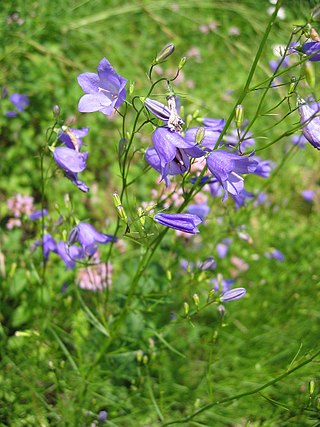
Campanula rotundifolia, the harebell, Scottish bluebell, or bluebell of Scotland, is a species of flowering plant in the bellflower family Campanulaceae. This herbaceous perennial is found throughout the temperate regions of the northern hemisphere. In Scotland, it is often known simply as bluebell. It is the floral emblem of Sweden where it is known as small bluebell. It produces its violet-blue, bell-shaped flowers in late summer and autumn.
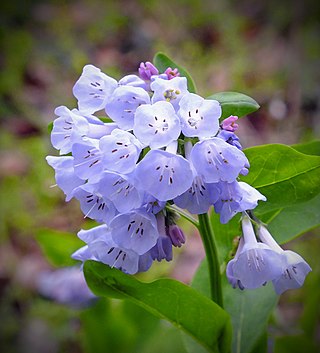
Mertensia is a genus of flowering plants in the family Boraginaceae. They are perennial herbaceous plants with blue or sometimes white flowers that open from pink-tinged buds. Such a change in flower color is common in Boraginaceae and is caused by an increase of pH in the flower tissue. Mertensia is one of several plants that are commonly called "bluebell". In spite of their common name, the flowers are usually salverform (trumpet-shaped) rather than campanulate (bell-shaped).

Mertensia virginica is a spring ephemeral plant in the Boraginaceae (borage) family with bell-shaped sky-blue flowers, native to eastern North America.
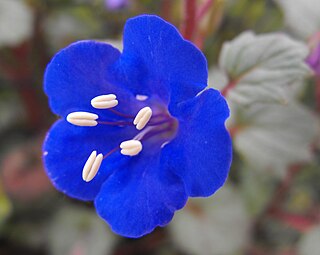
Phacelia campanularia is a species of flowering plant in the borage family, Boraginaceae, known by the common names desertbells, desert bluebells, California-bluebell, desert scorpionweed, and desert Canterbury bells. Its true native range is within the borders of California, in the Mojave and Sonoran Deserts, but it is commonly cultivated as an ornamental plant and it can be found growing elsewhere as an introduced species.

Viola beckwithii, known commonly as the Great Basin violet, Beckwith's violet, and sagebrush pansy, is a species of violet native to the western United States. It is an early-flowering plant of sagebrush habitats in the Great Basin region.

Goodyera oblongifolia is a species of orchid known by the common names western rattlesnake plantain and giant rattlesnake plantain. It is native to much of North America, particularly in the mountains of the western United States and Canada, from Alaska to northern Mexico, as well as in the Great Lakes region, Maine, Quebec and the Canadian Maritime Provinces.
Boechera cobrensis is a species of flowering plant in the mustard family known by the common names Masonic rockcress and sagebrush rockcress. It is native to the western United States from eastern California to Wyoming, where it is found in sandy habitat, especially sagebrush. This is a perennial herb growing several erect, slender stems to heights near half a meter from a branching caudex. The plant forms a narrow clump with a base of narrow, linear, densely hairy leaves up to 5 centimeters long. There are also a few slightly shorter leaves clasping the stems at intervals. The top of each stem is occupied by an inflorescence of small, nodding flowers with dull yellowish sepals and white petals. The flowers give way to fruits which are narrow, straight siliques up to 4 centimeters long containing winged seeds.

Mertensia ciliata is a species of flowering plant in the borage family known by the common names tall fringed bluebells, mountain bluebells, and streamside bluebells.
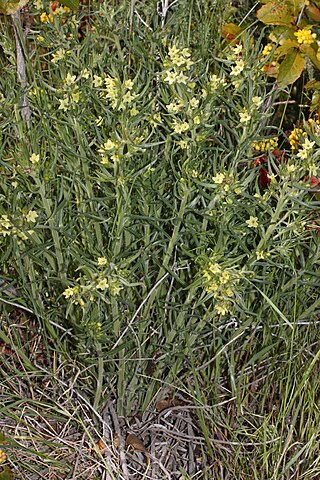
Lithospermum ruderale is a species of flowering plant in the borage family known by the common name western stoneseed or lemonweed. It is native to western Canada and the western United States, where it can be found in many types of habitat. A perennial herb growing from a taproot and woody caudex, it is covered with fine, more or less upright, hairs, especially on the stems. It produces a cluster of erect leafy stems ranging from 20 to 50 centimetres centimeters in height. The stems support lance-shaped leaves ranging from 2.5–10 cm (1–4 in) in length. Bunches of flowers with leaf-like bracts appear toward the top of the stem amongst the leaves. The corolla is fused at the base with five lobes which are light yellow, often slightly greenish, and about a centimeter long and wide. The style is short. The fruit consists of one or two, sometimes four, clustered glossy grey nutlets, 3.5 to 6, sometimes as much as 8 mm long.

Mertensia bella is a species of flowering plant in the borage family known by the common names beautiful bluebells and Oregon lungwort. It is native to the northwestern United States, where it grows in wet mountain habitat. It is a perennial herb producing a slender, erect stem and caudex unit up to half a meter tall. The rough-haired leaves are alternately arranged and borne on petioles. The inflorescence is an open array of clustered bright blue, bell-shaped flowers up to a centimeter wide at the lobed mouths.

Mertensia longiflora is a species of flowering plant in the borage family known by the common names small bluebells and long bluebells.
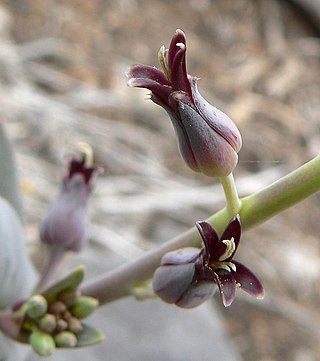
Streptanthus cordatus is a species of flowering plant in the mustard family known by the common name heartleaf twistflower. It is native to the western United States, where it can be found in many types of sagebrush, woodland, and forest habitat. It is a perennial herb producing a branched or unbranched stem up to about a meter tall. It is often waxy in texture. The basal leaves are oval or spoon-shaped with bristle-toothed blades borne on rough-haired petioles. Leaves higher on the stem are oval to lance-shaped, up to 9 centimeters long with their bases usually clasping the stem. Flowers occur at intervals along the upper stem. Each has a calyx of sepals roughly a centimeter long which begin greenish yellow and mature purple. Four purple petals emerge from the tip of each calyx. The fruit is a thin, narrow silique which may reach 14 centimeters in length or longer.

Toxicoscordion paniculatum is a species of flowering plant known by the common names foothill deathcamas, panicled death-camas, and sand-corn. It is widely distributed across much of the western United States, especially in the mountains and deserts of the Great Basin region west of the Rocky Mountains. It grows in many types of habitat, including sagebrush plateau, grasslands, forests, and woodlands, etc.

Mertensia paniculata, also known as the tall lungwort, tall bluebells, or northern bluebells, is an herb or dwarf shrub with drooping, bright-blue, bell-shaped flowers. It is native to northwestern North America and the Great Lakes.

Schoenocrambe argillacea is a rare species of flowering plant in the mustard family known by the common names clay reed-mustard, Uinta Basin plainsmustard, and clay thelypody.
Viola frank-smithii is a rare species of violet known by the common name Frank Smith's violet. It is endemic to Utah in the United States, where it is known only from Logan Canyon in the Bear River Range in Cache County.
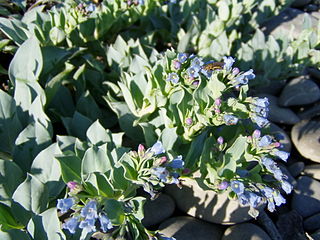
Mertensia maritima is a species of flowering plant in the borage family, and is known by the common names oyster leaf in North America, oyster plant in the British Isles, and sea bluebells.

Mertensia lanceolata, known as prairie bluebells, narrow-leaved languid lady, lance-leaved bluebells, and lance-leaved lungwort is a species of flowering plant native to western North America. A herbaceous perennial it has blue-green leaves alternately arranged on its smooth flowering stalk. Its flower buds are pink-purple and become more blue as they open. Accepted varieties include:

Mertensia sibirica, commonly known as Japanese bluebells or Siberian bluebells, is a species of flowering plant belonging to the family Boraginaceae. Originally discovered by Carolus Linnaeus, who named it Pulmonaria sibirica, this plant is found, as its name implies, in Eastern Siberia and northern China. After review of the plant's morphology, its taxonomic position was changed to Mertensia sibirica by botanist and plant collector George Don, who put forth the notion of the change, which was eventually accepted, most likely due to the striking resemblance to the related species in the Americas like Mertensia virginica, or Virginia bluebells.


















